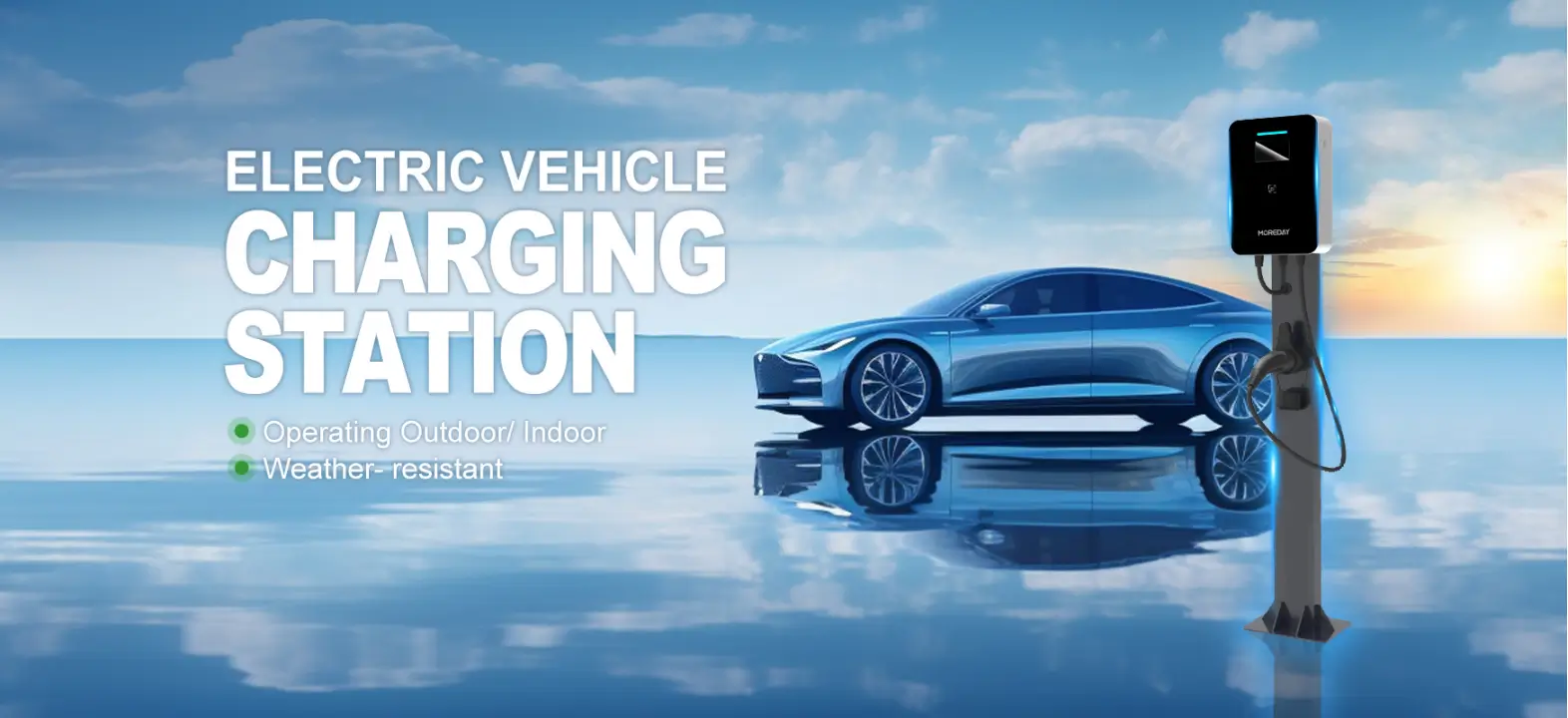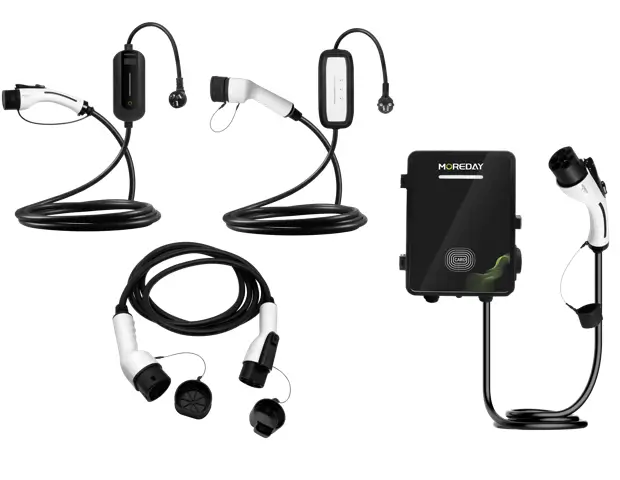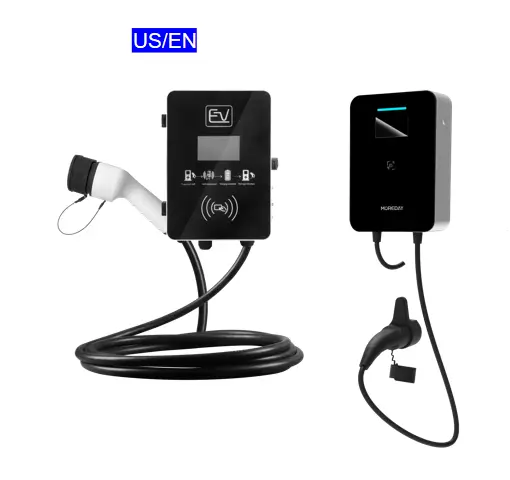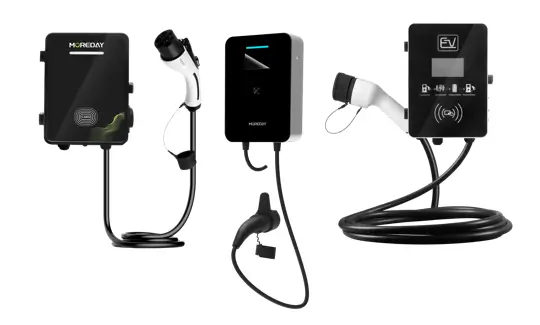Table of Contents
ToggleLearn About EV Charging Station Choices In Every Country
Introduction
As the world shifts towards sustainable transportation solutions, electric vehicles (EVs) have gained significant traction. With this rise in EV adoption comes the crucial need for accessible and efficient charging infrastructure.
As the demand for EVs grows, the infrastructure to support these vehicles becomes paramount. One key aspect of EV infrastructure is the availability and variety of charging options in different countries. In this article, we’ll delve into the diverse EV charging station choices offered around the world, highlighting the strategies and innovations each country employs to cater to their EV users.
“Choosing a suitable EV charging station is crucial to the charging of electric vehicles”ChuanFu Wang CEO FROM BYD
EV Charging Station Overview
EV Charging Station refers to a charging device that provides energy supplement for electric vehicles. Its function is similar to that of a fuel dispenser in a gas station. It can be fixed on the ground or wall and installed in public buildings (public buildings, shopping malls, public parking lots, etc.) and residential areas In the parking lot or charging station, various types of electric vehicles can be charged according to different voltage levels. The battery of an EV can only receive direct current (DC) and voltage, while the grid/household outlet provides alternating current (AC), so the home charging station converts the AC to DC and then charges the EV battery.
AC Charging VS DC Charging
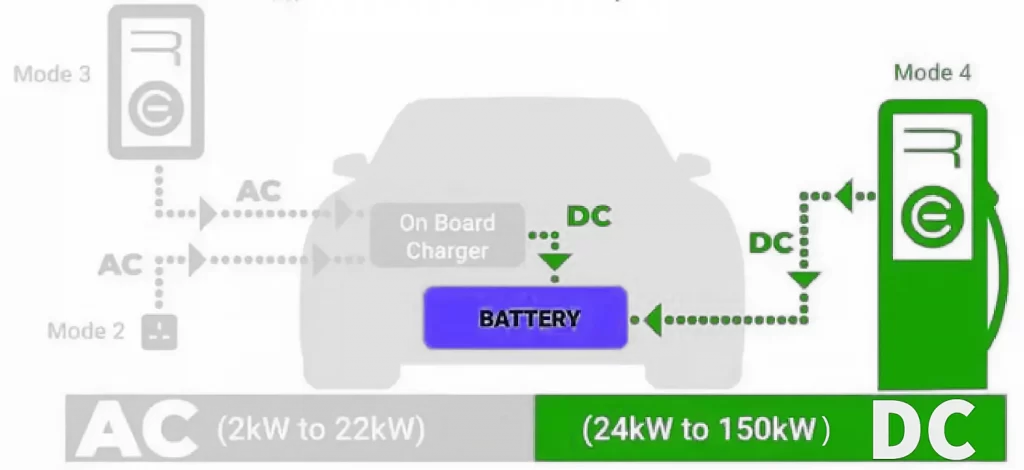
AC charging : power supply (AC) → AC charger → car charger (AC to DC) → battery
DC charging : power supply (AC) → DC charger (AC to DC) → battery
The AC Charging Process
During AC charging, the EV’s onboard charger converts AC power to DC power and controls the charging process. AC charging is typically slower than DC charging, making it suitable for overnight charging or longer parking durations.
AC charging is widely available and compatible with most EVs, making it a convenient option for daily use. However, its charging speed is relatively slower compared to DC charging.
The DC Charging Process
Direct Current (DC) charging, on the other hand, offers higher charging speeds and is often used for rapid charging scenarios.
DC charging stations directly provide DC power to the EV’s battery, bypassing the need for an onboard charger. This results in faster charging times, making DC charging ideal for drivers on the go.
Appearance of MOREDAY AC and DC Charger
Bulky, must be installed by a professional electrician, requires a larger space.
EV Charger Connector Type
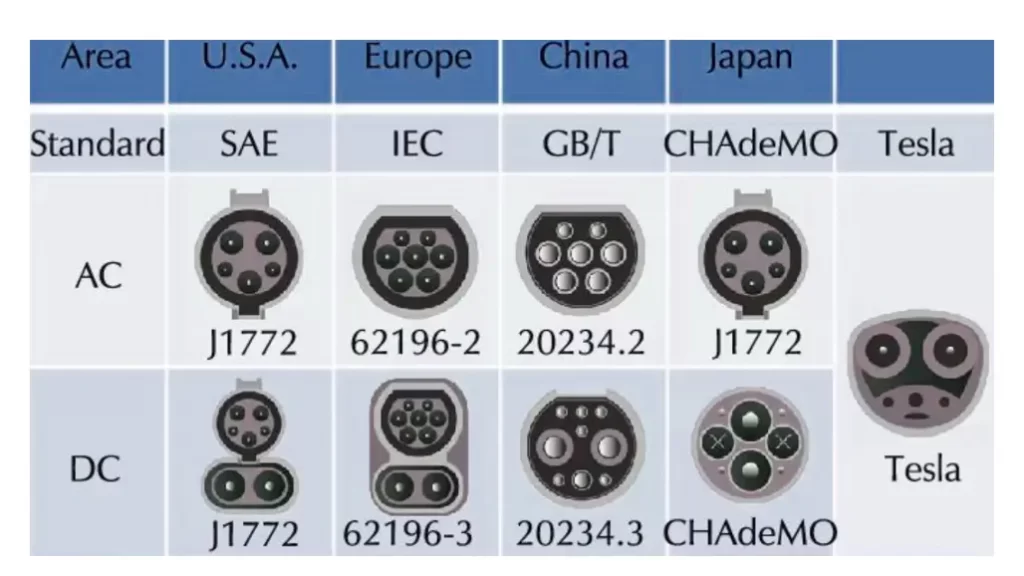
Type 1 (SAE J1772): This connector is widely used in North America and Japan. It has a J-shaped design and is intended for single-phase AC charging.
Type 2 (IEC 62196-2, also known as Mennekes): This connector is commonly used in Europe and supports both single-phase and three-phase AC charging, as well as DC charging.
CHAdeMO: This connector type is primarily used for DC fast charging and was developed in Japan. It’s commonly found on electric vehicles in Japan and some other regions.
Combo Connector (CCS, Combined Charging System): This connector integrates both AC and DC charging into a single design. It combines the Type 2 connector with additional DC pins for fast charging. CCS Combo 1 is primarily used in North America, while CCS Combo 2 is used in Europe and other regions.
Tesla Connector (Tesla Supercharger): Tesla has its own proprietary connector for their Supercharger network. However, they also provide adapters for other connector types.
GB/T Connector (GB/T 20234.2-2011): This connector is used in China for both AC and DC charging and has different variations for different power levels.
IEC 60309 (also known as IEC 60309-2 or “industrial plug”): While not specific to electric vehicles, this standard is sometimes used for high-power charging in commercial and industrial settings.
AC Charger Power Calculation Method
Calculating the power of an AC electric vehicle (EV) charger involves a straightforward formula based on the voltage and current ratings of the charger. The formula to calculate power is:
Power (Watts) = Voltage (Volts) × Current (Amps)
Here’s how you can use this formula to calculate the power of an AC EV charging station:
Determine the Voltage Rating: Check the specifications of the EV charging station to find the voltage rating. In most cases, AC EV chargers for homes or public charging stations have a voltage rating of either 120V or 240V.
Determine the Current Rating: Find the current rating of the car charger. It is usually mentioned in terms of amps (A). Common current ratings for residential chargers are 16A, 32A, 40A, etc.
Plug in the Values: Plug the voltage and current ratings into the formula:
Power (Watts) = Voltage (Volts) × Current (Amps)
For example, if you have a charger with a voltage rating of 240V and a current rating of 32A:
Power = 240V × 32A = 7680 Watts (or 7.68 kW)
Convert to Kilowatts (Optional): Power is often expressed in kilowatts (kW) for simplicity, as EV charging rates are commonly discussed in kW. To convert watts to kilowatts, divide the power value in watts by 1000. In the example above, 7680 watts is equivalent to 7.68 kW.
Remember that this calculation gives you the maximum potential power output of the charger. The actual power delivered to your EV might vary due to factors like the efficiency of the EV charging station and the charging cable.ing
The Main Types of EV Chargers in US:
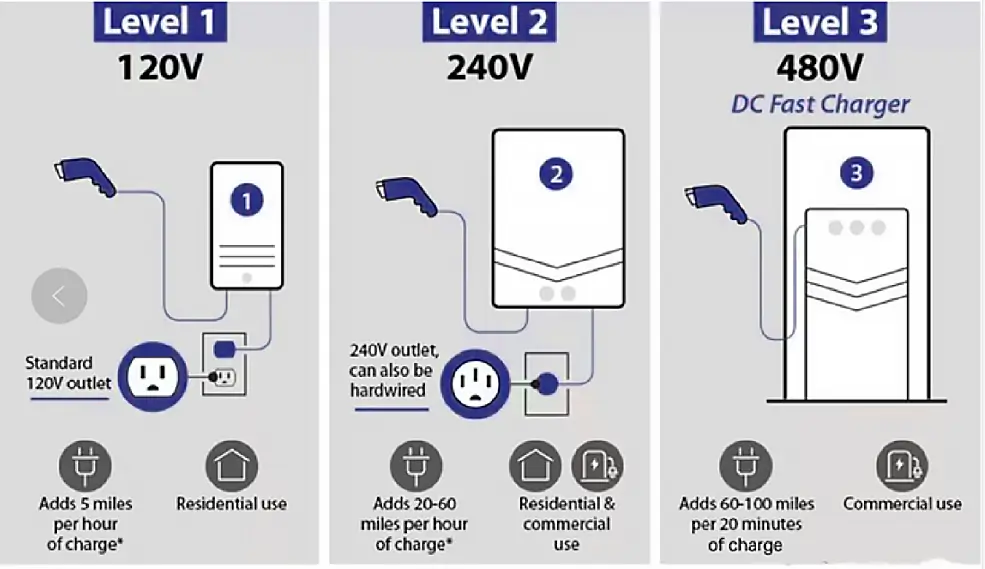
The easiest method of charging an electric car includes connecting it directly into a regular 120-volt household socket. This option charges at the slowest rate, often delivering 2 to 5 miles of range each hour. When overnight charging is adequate, it is frequently employed.
A dedicated EV charging station must be installed in order to use the more advanced Level 2 charging option. Compared to Level 1, these stations offer faster charging rates and operate on a 240-volt circuit. Both public charging stations and private settings frequently employ level 2 charging. Depending on the car and the charger’s power output, the rate of charging can be anywhere from 10 to 60 miles per hour.
The quickest charging technique is DC fast charging, which is frequently utilized for long-distance travel or when fast charging is required. Specialized equipment is needed for this sort of charging, which is often offered at public charging stations. With a DC fast charger, you can get a lot of range quickly. Typically, you can get 60 to 100 miles of range within 20 to 30 minutes of charging.
The Main Types of EV Chargers in EUROPE:
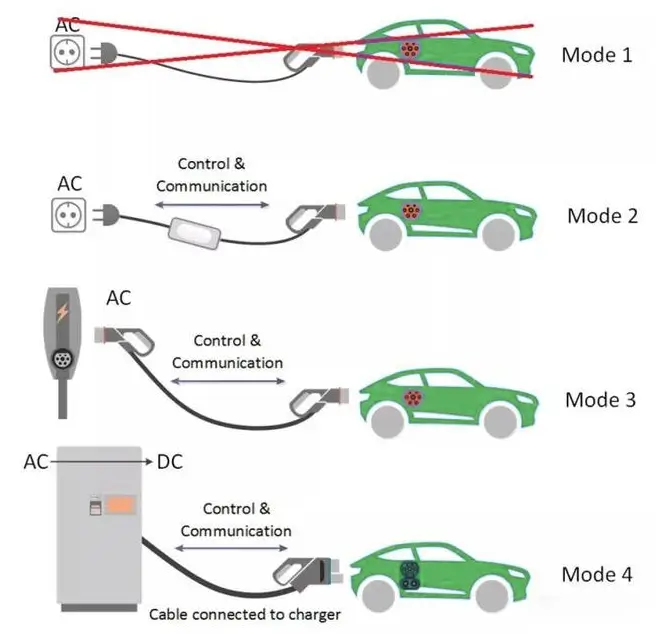
Mode 1 Charging:
The simplest type of charging, known as mode 1 charging, involves connecting the EV to a regular household outlet with the charging cable that was included with the car. It does not require any additional control mechanisms or charging apparatus. However, due to its restricted power capacity, this method may not be the best or safest choice for routine EV charging.
Mode 2 Charging:
Using a charging cable with an integrated control and safety device is how mode 2 charging is accomplished. The car is connected to this control box, also known as a “charging station” or “control unit,” which is located between the vehicle and a typical household outlet. Compared to Mode 1 chargers, Mode 2 chargers offer some protection and control over the charging process, improving safety.
Mode 3 Charging:
Mode 3 charging is the most common method for public and home charging stations. It involves a dedicated EV charging station (also known as an Electric Vehicle Supply Equipment or EVSE) that is permanently installed and provides higher power levels. Mode 3 chargers are connected to the electrical grid and the vehicle using specific connectors, and they include safety features and communication protocols to ensure safe and efficient charging.
Mode 4 Charging:
Mode 4 charging is typically used for fast charging at public EV charging stations. This mode involves a DC (direct current) charger that provides very high power levels and requires specialized infrastructure. Mode 4 chargers are not as common for home use due to their complexity and cost.
Single-Phase Charging:
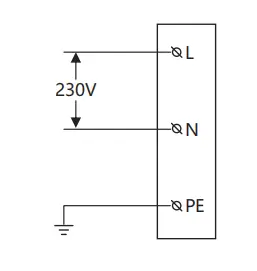
Single-phase EV charging stations are designed to work with single-phase AC power. They are commonly used for residential charging, such as home lighting, appliances, TVs, washing machines, etc. Single-phase electricity has three wires, live wire, neutral wire and ground wire. The equipment takes power through the live wire and the neutral wire, and the voltage between the two wires is 230 volts. Single-phase charging is suitable for lower power charging needs, such as overnight charging at home.
Single-Phase Charging:
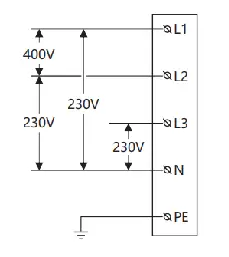
Three-phase EV charging stations are designed to work with three-phase AC power. Three-phase power is used for some high-power residential power supply, mainly for industrial high-power manufacturing equipment. Three-phase electricity generally has 5 wires, three live wires, one neutral wire, and one ground wire. The equipment takes power through three live wires, and the voltage between each two live wires is 400 volts. Three-phase power enables more efficient and faster charging, making it suitable for charging larger electric vehicles or when faster turnaround times are required. These chargers are typically used in commercial and public charging stations, and where higher charging speeds are required.
Basic Functions of AC Charger
1.Charging Guide
Communicate with the car, control the start and stop of charging, and inform the car how much charging current should be limited.
2.Charging Protection
1. Overvoltage and undervoltage
2. overcurrent
3. Leakage AC 30mA+DC 6mA (the charging pile sensor itself has DC6mA + Type A leakage detection)
4. Poor ground protection
5. over temperature protection
6. Poor contact of the connector
Detect the rated current of the external cable, if it cannot be detected, it cannot be charged.
7. Motor lock fault (pile end motor lock)
8. PEN protection
TN-C-S power grid system, when the neutral wire of the grid is disconnected, the charging pile will cut off the ground wire connection with the vehicle
3.Load Balancing DLB
1. Ordinary family scene (one charger at home)
In order to prevent the distribution box from being overloaded.
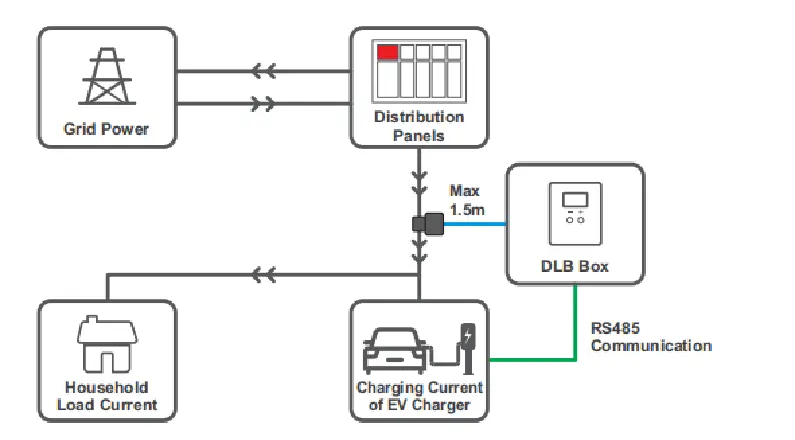
2.Two or more chargers load balancing DLB
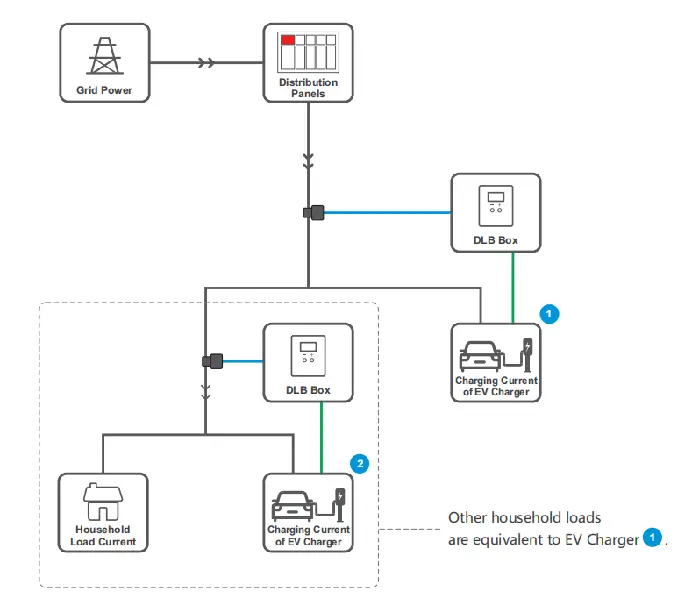
3.Home photovoltaic application load balancing DLB
Allow users to use photovoltaic power to charge charging piles as much as possible to reduce electricity usage.
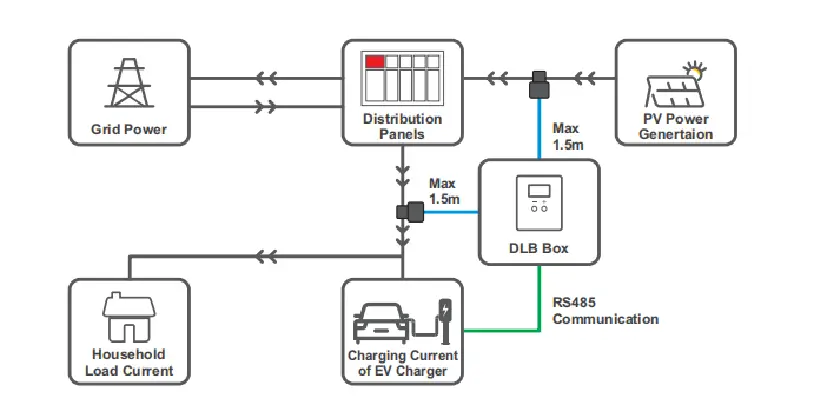
4.Small parking lot load balancing DLB.
Use communication to monitor the charging data of all chargers.
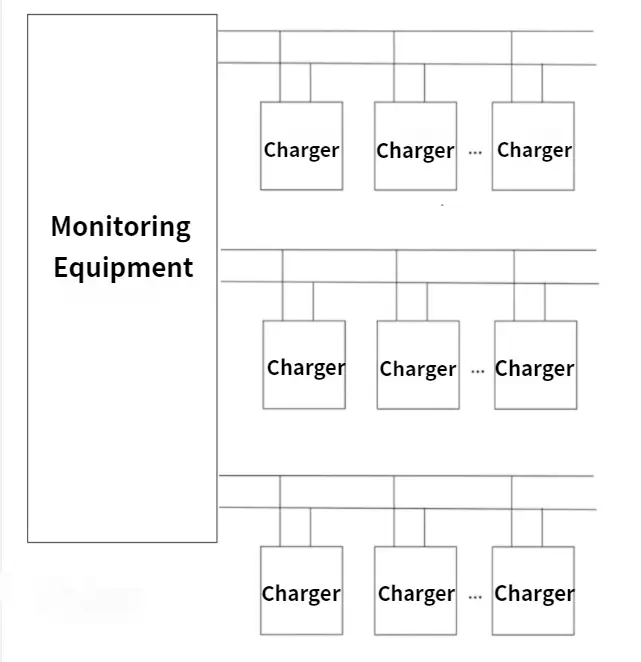
Introduction of MOREDAY CHARGER APP
MOREDAY EV charging station is connected to Bluetooth to achieve functional configuration. The mobile phone APP can realize the control of the charger. The APP and the charger are connected through the ESP32 Bluetooth module to realize the function of controlling the charger. You can download the new version of the firmware through Bluetooth/WIFI to update the charger program to the new one. Version.
1.Download Method
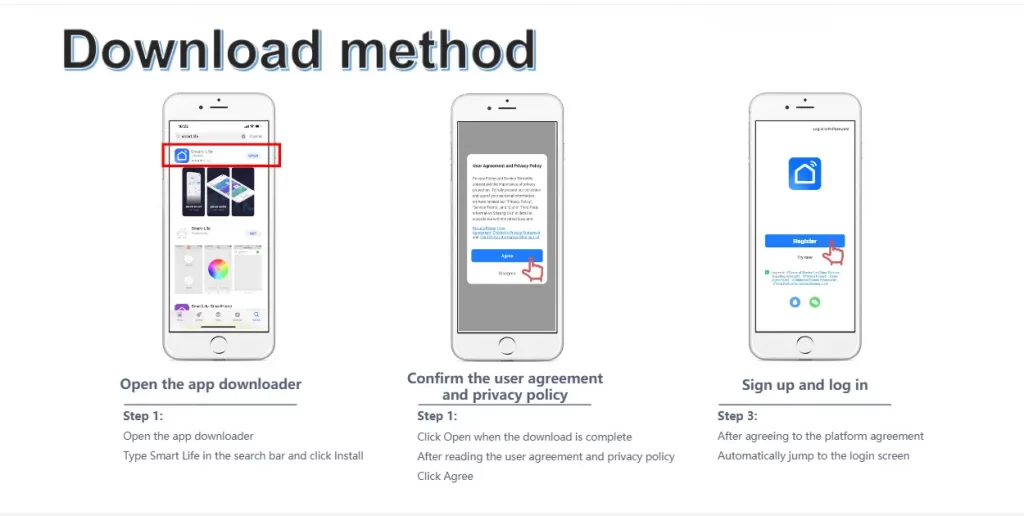
2.Log In
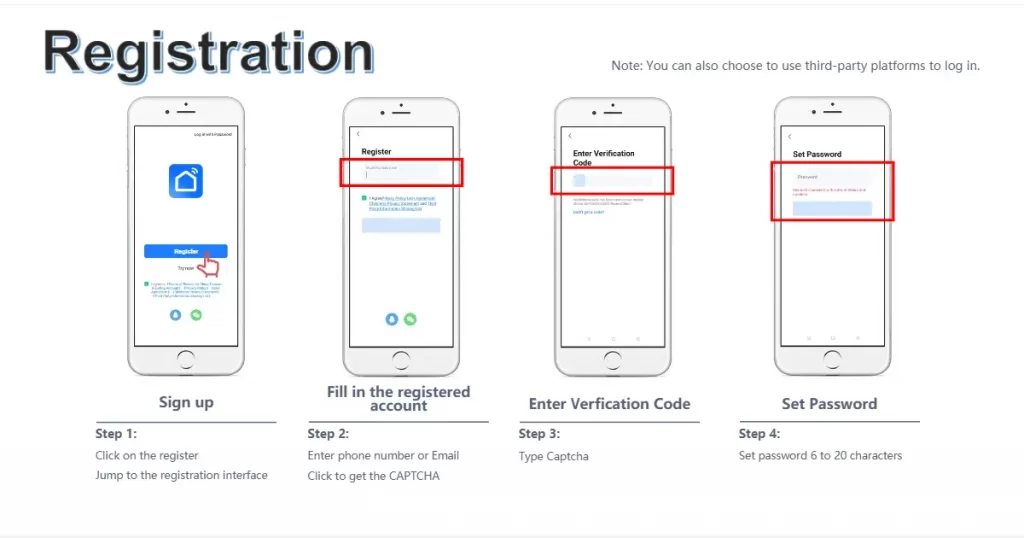
3.Add Device
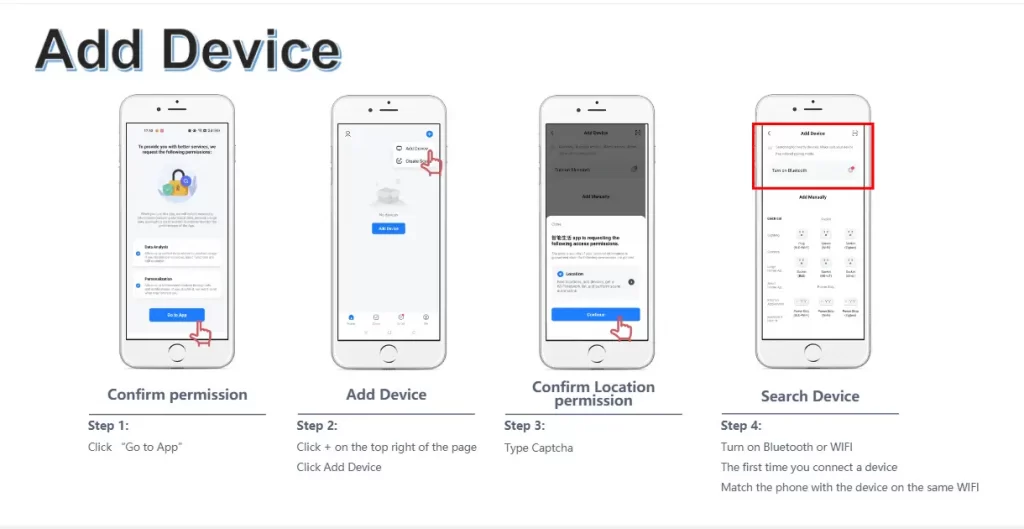
4.Charging Step
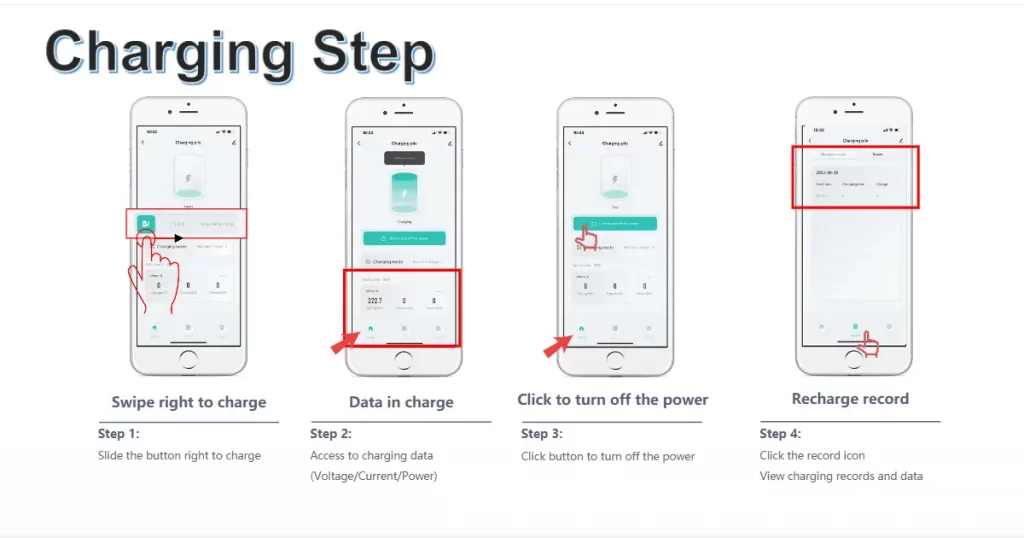
5.Schedule
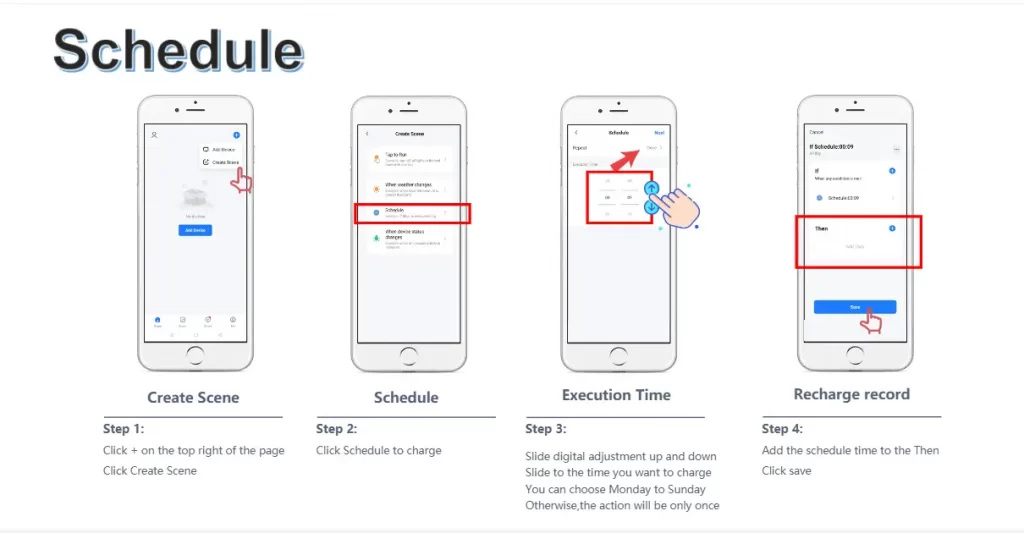
1. Dynamic load balancing (DLB) function (optional): no need to apply for a separate electricity meter, the existing power distribution resources can be used to detect the total current value of the household in real time, and automatically adjust the charging current of the vehicle, so that the total current of the household can be controlled at the rated value Within the value, prevent overload tripping.
2. Photovoltaic DLB function (optional): Photovoltaic DLB can limit EV charging stations to use mains electricity for charging, which can save electricity costs.
3. 0-PEN protection function: When the grid mode used by the EV charging station is TN-C-S, when the neutral wire of the grid is broken, the charging station will cut off the connection with the ground wire of the vehicle to prevent the vehicle shell from being charged due to the disconnection of the zero wire.
4. Adopt B-type leakage sensor: B-type leakage sensor is used inside the charging pile, which has a higher level of safety (AC 30ma+DC 6ma)
5. Leakage detection function: Built-in leakage detection, input 10mA real DC leakage to the leakage sensor to ensure that the leakage protection function is in normal working condition.
6. Vehicle protection function: In the mode of swiping the card, the user stops charging by swiping the card, and the EV charging station will wait for the charging current of the vehicle to decrease before disconnecting the charging power supply to protect the charging system of the vehicle from damage.
7. APP function: the smart model can be connected to the mobile APP through Bluetooth to manage various states and functions of the charging pile (such as start charging, stop charging, regular charging, quantitative charging, set charging current size, view charging records/charging details, firmware upgrades ).
8. Highlight light strip: LED lights are used to display different colors and actions, and intuitively indicate various working states and fault types of charging piles.
9. Card swiping without a gun: It supports card swiping without a gun. After swiping the card, the authentication state lasts for one minute, and the gun can be inserted and connected to the vehicle within one minute to charge.
10. Restart after charging interruption: If there is a power failure during the charging process, it will automatically continue charging after the power is restarted to avoid charging suspension caused by a short power failure.
11. Fault reset: If there is a fault during a single charging process, it can reset itself after a certain period of time and continue charging (with a limit on the number of resets), to avoid charging interruption caused by a short-term fault.
12. Independent gun holder for gun insertion: the pile body uses an independent socket to fix the charging gun, which is simple and elegant.
13. Easy to hang the line: the unique design can easily store and hang the charging cable.
14. Multiple wiring methods: bottom wiring, inner hole wiring, and upper wiring (optional wiring board base is required)
15. Card swiping function: can be equipped with card swiping function or plug and play to meet the different needs of different customers.
16. Multi-level charging current/power setting: Up to 8 levels of charging current/power can be set to meet the needs of different users to choose different charging currents for different grid loads.
17. Perfect protection functions: emergency stop protection, abnormal CP signal protection, poor grounding/neutral live wire reverse connection protection, undervoltage protection, overvoltage protection, overcurrent protection, high temperature protection, leakage protection, adhesion detection, etc.
18. Support for multiple connection methods: three-phase charging piles support single-phase, two-phase, and three-phase connections, which is convenient for users to choose the connection method according to their own grid conditions.
19. Open RS485 protocol: users can connect to other devices in the family through the communication protocol of RS485 interface, and manage and control the charging pile (this function requires the agent to adapt the supported communication equipment by himself)
20. Support OCPP 1.6: With OCPP charging pile, support OCPP 1.6 protocol.
Conclusion
In conclusion, the EV charging station choices available in every country play a pivotal role in shaping the future of sustainable transportation. From North America to Europe and Asia, each region has adopted strategies tailored to its unique needs. As the world shifts towards cleaner mobility, the diverse charging options contribute to a more accessible and convenient EV ecosystem. By embracing innovation, government support, and collaborative efforts, the global transition to electric mobility continues to gain momentum.MOREDAY provides car charger products that meet global requirements, and can provide OEM/ODM services to facilitate customers to customize personalized products.
Derek Ke
Hey, I’m Derek Ke, the founder of Moredaydc.com, an expert in solar electrical products and ev charging.
In the past 15 years, we have helped 60 countries and nearly 500 customers (such as farms, residences, industrial and commercial) solve new energy and green power problems. This article aims to share more knowledge about solar electricity and new energy with everyone, so that green electricity can enter every home.
Common Queries
Frequently Asked Questions
Please Feel Free To Contact Us.
A: EV chargers come in various types, and compatibility depends on the charging standard used by the manufacturer.
A: Charging times vary based on the charger type and the vehicle’s battery capacity. Level 2 chargers are faster than Level 1, while DC Fast Chargers offer rapid charging.
A: No, different regions utilize various charging standards and connectors.
A: Bidirectional charging allows EVs to transfer energy to the grid, aiding in balancing energy demand.
A: Range anxiety is the fear of not having enough charge to reach your destination. It’s becoming less of a concern with growing charging infrastructure.
Make Electricity Available To All People

